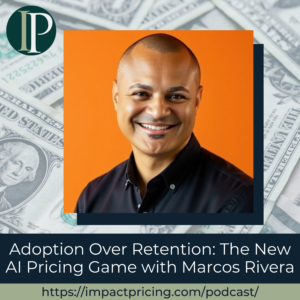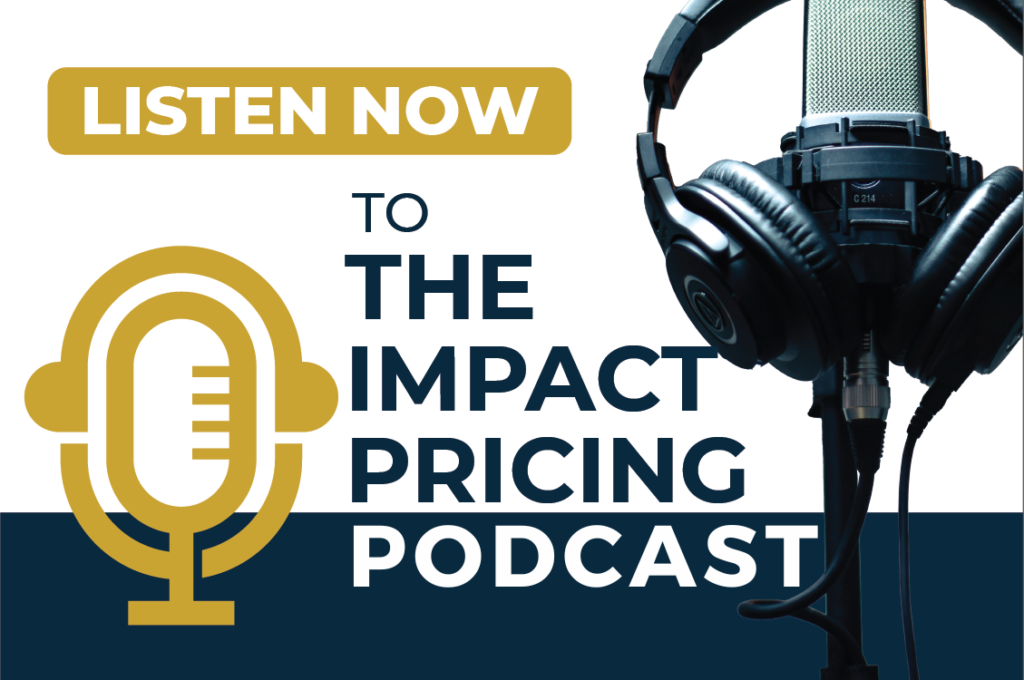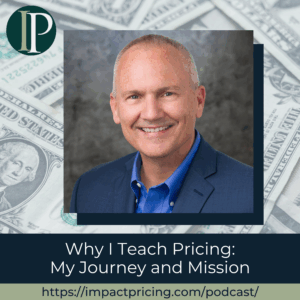Marcos Rivera is the founder of Pricing I/O and author of “Street Pricing.” He brings 25 years of pricing experience, including a three-year tenure as an operating executive at Vista Equity Partners where he worked on pricing strategies across multiple portfolio companies. He’s been running Pricing.io since 2019 and is passionate about the intersection of pricing and AI.
In this episode, Marcos shares his insights on the evolving landscape of pricing in the age of AI, the importance of capturing value, and how companies can differentiate themselves in a competitive market. Together, they discuss the shift from traditional pricing models to outcome-based pricing and the role of AI in enhancing pricing strategies.
Podcast: Play in new window | Download
Why you have to check out today’s podcast:
- Discover how AI is changing the pricing landscape and what it means for businesses.
- Explore the relationship between pricing, value, and customer outcomes.
- Learn about the importance of low-friction entry points in pricing strategies.
“AI forces you to walk the walk versus talk the talk.”
– Marcos Rivera
Topics Covered:
02:48 – The evolution of pricing in SaaS where the system gets credit for capturing more value using AI
05:36 – The significance of capturing value quickly and efficiently.
08:09 – Differentiation in a competitive market and the role of pricing power.
12:16 – The importance of entry points and reducing friction for customers.
14:44 – How product design and pricing design are interconnected.
17:07 – The challenges of pricing in the AI landscape.
18:59 – Marcos’s approach to using AI in pricing strategies.
28:56 – Pricing advice from Marcos.
Key Takeaways:
“Pricing is about capturing value, and AI opens up new opportunities for that.” – Marcos Rivera
“Entry points matter; make them as low friction as possible.” – Marcos Rivera
“Understanding how to differentiate your offering is crucial in a crowded market.” – Marcos Rivera
Resources and People Mentioned:
- Steven Forth: https://impactpricing.com/podcast/691-pricing-in-the-agent-economy-the-future-beyond-subscriptions-with-steven-forth/
- Vista Equity Partners: https://www.vistaequitypartners.com/
- Pricing I/O: https://www.pricingio.com/
- Finn AI: https://www.glia.com/
- Zendesk: https://www.zendesk.com/
- Cursor: https://www.cursor.com/
- HubSpot: https://www.hubspot.com/
- Salesforce: https://www.salesforce.com/
- Snowflake: https://www.snowflake.com/en/
- Netflix: https://www.netflix.com/
- Slack: https://slack.com/
- 99designs: https://99designs.com/
- DeepSeek: https://www.deepseek.com/en
- ChatGPT: https://openai.com/
- Claude: https://claude.ai/
- Grok: https://grok.com/
- Perplexity: https://www.perplexity.ai/
Connect with Marcos Rivera:
- LinkedIn: https://www.linkedin.com/in/marcoslrivera/
- Website: https://www.pricingio.com/
Connect with Mark Stiving:
- LinkedIn: https://www.linkedin.com/in/stiving/
- Email: [email protected]
Full Interview Transcript
(Note: This transcript was created with an AI transcription service. Please forgive any transcription or grammatical errors. We probably sounded better in real life.)
Marcos Rivera
Your entry is probably too complex and has a lot of friction. The entry point, I think, matters so much. And a lot of companies, they’re always trying to figure out how to monetize in the biggest, most complex use cases and the deepest usage. But I think not enough attention is paid to how you get started.
[Intro / Ad]
Mark Stiving
Welcome to Impact Pricing, the podcast where we discuss pricing, value, and the dynamic relationship between them.
I’m Mark Stiving, and I run boot camps to help companies get paid more.
Our guest today is the one and only Marcos Rivera. Here are three things you want to know about Marcos before we start.
He is the author of Street Pricing. He’s been running Pricing I/O since 2019. I’m impressed. He was an operating executive at Vista Equity Partners for three years, which meant he got to play with pricing with many, many different companies. Oh, that’s already three, but he’s a huge music fan. I know that because I’ve heard him talk before.
And finally, he was a guest two and a half years ago on the podcast, and I’m shocked it’s taken so long to get him back.
Welcome, Marcos.
Marcos Rivera
Mark, thanks for having me back on, man. I appreciate it. So I didn’t offend you too much in that first one to bring me back.
So I love it.
Mark Stiving
I don’t think you offended me, but if you did, I’m over it.
Marcos Rivera
Excellent. Excellent. I like your style, man.
Thanks for having me.
Mark Stiving
Hey, no worries. It’ll be fun.
Okay. Normally I start with the question, how’d you get into pricing? We did that a couple of years ago. I want to jump right into AI. We had like a 10 second conversation before I hit record and the conversation went something like, I’m so far behind, right? I have no idea what’s coming up.
I think of AI in two really distinct ways. One is, how do you use AI to help you do pricing?
And the other is, how do you price AI products that are coming out?
So I’m going to toss both of those out to you. Which one of those is exciting to you and how are you thinking about it?
Marcos Rivera
Man, I’m loving both of these.
Let’s start with the pricing AI piece because I think that’s where a lot of listeners are probably wondering in the back of their minds, like, how do I price this stuff?
So we can get into that.
Mark Stiving
Yep. Okay. How do you price AI?
So I have Steven Forth on quite often, and he does a lot of research and thinking about AI and pricing AI.
And the thing I always tell him is, it’s the same thing as pricing anything else, right? It’s about value.
How much value are we delivering to the customer? So, how am I wrong on that?
Marcos Rivera
Yeah, you’re not wrong. Steven is brilliant and he’s fascinated with how the value equation or paradigm shifts a little bit with AI.
So let me backup a little bit because I had conversations with Steven and others in the pricing community about pricing AI.
And the one thing that I’m noticing about why this is different than pricing anything else. Now, I think capturing value is still capturing value, right?
But I think what AI does is it opens up a new door to capturing a bit more value in areas where the AI has higher clear attribution to getting that value. Let me explain.
In the SaaS software world, right? And I’ve been doing this for 25 years. You’ve been doing this for a while, right? We’ve, we’ve been in this thing for decades.
And in the beginning, when I was pricing on prem stuff, it was all about access to the software. You get, you pay some fee, you pay some maintenance on top of that, usually 15, 20% of that and whatever, and you move on.
There was a shift that happened with cloud online that allowed us to design tech stacks that had a lot better telemetry, had a lot better visibility into the activities going on, what humans were doing with the system, which opened up the doorway to subscription and even to some degree consumption-based pricing models.
And now with AI, I feel like it’s taken an evolutionary step forward where now it’s not just humans doing stuff with systems, it’s systems doing stuff for humans.
And now you can attribute the resolution of a call or the editing of an image or the sending of an email to the system doing it without the human. And therefore the system gets a little more credit and should capture a little more value.
And this is, some are calling this the holy grail. I wouldn’t go that far, but what I was trying to say here is that now you can charge for things that are a little bit more aligned to value. which opens up a whole another set of techniques and also problems, and the problems we can get into as well.
But I think it’s just changing a little bit more of what’s possible, not necessarily just the old adage of, ‘hey, how do you capture value?’ It’s just now opening up different opportunities.
Mark Stiving
Okay, let’s walk through an example.
You brought up the idea of editing an image, which is probably the hardest example I could give you, but let’s talk through that for a second.
In the old days, I would hire a graphic designer. Right?
And the graphic designer is going to go through and give me a design. And maybe in the newer days, I would hire 99 designs or whatever that, a bunch of people send me a design and bid on it and I’d pay for it.
How is it that AI, I mean, obviously AI can craft a picture for me and I could ask it a hundred different times. It’ll give me a hundred different pictures, but how is it that we now have the ability to capture value that we didn’t have before?
Marcos Rivera
It’s interesting, because the value is there. And here’s the thing about value that I find interesting.
And you know more about value than most people, because you wrote a freaking book on it. But I would say that the ability to capture value also depends on how you use it. the effort and time to get to value.
And what I mean by that is, the more time and the more energy you have to take, the more risk in getting the value, the less of it you can capture in your pricing model up front.
I think if you get people to value faster or with lower risk, there’s more consistency. And again, if you’re the one driving that value that they normally can’t get themselves, then you can capture a bigger percentage of that.
The whole value exchange formula that we all know and love. Where I’m thinking in the image example, if the AI is getting you there far faster, think about what happens, right? You got 99designs, you use that example, right?
You got to wait for the freaking bids, you got to review 15 different bids, you got to go through it, you got to think, you got to wonder.
All that is keeping you to the thing you want, which is, a logo or a change image or whatever that is. All those things keep you what you want.
When AI does it and it does it for you in rapid form, guides you, takes the input, is able to show you options that you can almost immediately react to, then it gets you to that final outcome faster and then you can capture that.
And the value of capturing that, believe it or not, I think goes up when it’s faster and easier to get to value. And that’s one of my biggest things that I think a lot of people talk about is they talk about value, but it’s actually how you get to value matters as well.
Mark Stiving
So I would certainly agree – let’s skip AI for a second, right? I would certainly agree that if you can solve my problem faster, if you can solve my problem with less risk, it is worth more to me, right?
So I would pay you more money to do that. But now let’s add AI to the story. We know that AI can do that, but it turns out there are multiple different AIs that can do that.
So we still have this ‘which one’ conversation that says, great, Marcos has created this beautiful image design, he can do it faster, and he charges a little bit less than if you hired a graphic designer.
But Mark, I went out and I created one and I charge like 10% of what a graphic designer charges because, you know, I’m not as greedy as Marcos is, right?
And so, we still have that one conversation that’s driving down the price.
And so, value is not only what’s the value of solving the problem, but it’s what’s the value relative to the alternatives that are out there.
Marcos Rivera
You are 100% right on that.
I’m going to double click on that for a second, because that touches something else, a related issue around pricing power. And so, if your framing of your AI and value is really singular or single dimension, only time, what’s to stop the next AI to say, I can do it faster, right?
And then starts this race to the bottom. I call it, I like to call it seven minute abs, right? Have you ever seen that movie with something about Mary, right? Eight minute abs.
Well, I’m going to come out with seven minute abs and six minute abs, right? It’s just going to keep pushing it down. My point in that is there needs to be something else beyond just the time savings.
Pricing power, if you just go back to old-fashioned high school physics, power equals work over time, right?
And so, if you’re able to reduce the time, then you can charge and you can capture more pricing through more pricing power.
But you also can increase that work, which if you want to get even nerdier is force times displacement, right?
And so, when you think about that, what else can you do to add to the value equation? Yes, you could do it faster. Wonderful.
So can the next guy. What else can you do? That’s the piece that I’m pushing and challenging these AI companies out there to get very crisp on. It could be as simple as a tangential use case that they also solve.
It could be one of the things that they talk about often, which is, we’re getting smarter with more problems we solve for you and therefore we can turn around and solve more problems.
And then third, our ability to either take everything we learn and then unlock even new potential that you never had before. I’m going back to even models like Finn AI and in the agentic AI space with call service reps.
This is one of the first use cases of AIs that came out, right? And the biggest thing is I can resolve your phone calls faster without a human agent on these calls. And then what does Zendesk do? You saw what they did. They came out with their agent. They’re like, well, we can do it, and we can even do it faster.
And now you have a, we’ll do it for 99 cents, and we’ll do it for 98 cents. And then therein starts the problem, right? But what Finn did, I thought was really clever, was they said, hey, we can actually now take some of these use cases and apply them to sales as well. Meaning on the other end of the customer service spectrum in the beginning, we can take what we learned here and apply it there because the issues that come up in service, you can actually repackage those and use those as selling points in the beginning.
And I thought that was super clever to take the value you’re giving in one area, in one use case and apply it to the other. Because what ends up happening in human behavior, you know this Mark, the moment you start using it in multiple places, it’s harder to rip it out. Humans, they don’t want to change a bunch of stuff all over the place.
But if you’re only in there and you’re only solving one singular problem, and you’re only saying we save you time, you, I think, as an AI provider, are setting yourself up to be disrupted or to be usurped by some other company that says they can do it cheaper.
Mark Stiving
Yeah, so I agree with everything you just said. By the way, I don’t want to sound like a naysayer. I love AI, right? I’m just, it’s like, I’m trying to figure out how to make all this stuff work. Now, here’s the problem.
Finn goes out and says, ‘hey, we’re going to apply this in a different application. We’re going to use this.’
So why wouldn’t Zendesk do the same thing? Right? And so, world, as soon as you come out with an agent, And you find a place where there’s a ton of value. Nobody’s captured it. I’m able to do this. I’m going to go look at your agent and say, hey, I can go create that too.
And now I have an agent. And then you say, yeah, but I’m going to make my agent do these three things, not just that one thing. And I say, well, guess what? I can make my agent do these three things, not just that one thing. Now, I’m totally with you on the switching costs, right? It makes it really hard, makes it stickier to get – once I am in, it makes it stickier to get it out if I’m doing a lot of different things, which then, of course, gives me more pricing power, more ability to raise prices over time, assuming I can win those customers in the first place.
So I’ll let you riff on what I just said.
Marcos Rivera
Yeah, I think there is going to be a quick copycat, catch-up game, all those things are going to happen because the technology is ubiquitous. You can access it. I can download Claude and ChatGPT and Grok and all those things right now and use them. And so can others.
And by the way, these things are coding itself and creating even more solutions faster. Think about how fast DeepSeek came out compared to ChatGPT.
My point here is that what you’re saying, I think is going to play out. I think that you’re going to see this game of cat and mouse and others, they’ll just keep coming up with new ways.
And so, where I think the play is, is the, in the SaaS world, it’s been all about retention. I think in the AI world, it’s going to be more about adoption.
And what I mean by that is, can you create mechanisms to adopt your AI faster with less friction than the other guy? And can you extend, can you again, get in and extend faster than the other. And what I mean by that is,going back to the Finn example, they include Finn in their most basic tier and plan.
And while Zendesk makes, they charge for it on top, these guys said, no, you know what, I’m going to include, and even better, I’m going to give you 10 calls for free. to get you going. Think about that on-ramp, right? And so, pricing and packaging can actually be used as they’re almost being weaponized to help drive that adoption, which helps get them in faster.
Now, I think they’re still going to get pressure from others to say Zendesk and other solutions, and they’re going to keep trying to break their way in either by solving a different use case and then attacking from a different angle.
And so, when I say agents against agents or this battle royale against different agents, I think that’s going to play out. And it’s exactly because of what you just said, it’s just that the innovation cycles are going to keep accelerating and the holding on to differentiation is going to be a lot tougher.
Mark Stiving
Okay. I want to ask a question about, and I’m going to step away from AI again for a second, because what’s fascinating about the conversation that you and I have just had is we actually weren’t talking about pricing. We’re really talking about packaging or new product development and being able to create, we’ll say, pricing power.
So how do you think about this whole concept that says, hey, as pricing people, we really influence what the product looks like?
Marcos Rivera
So you’re asking a very biased person because my roots are in product management. I learned how to price products, Mark, by actually pricing products.
Like I was building it, had to freaking figure out how to get sales to sell it and customers to use it. And so I had to come up with models. I failed miserably.
So I started reading up on it and trying to understand how do I price this stuff? And started, just was fascinated, you know, read,you know, several books, uh, Nagel, everybody else, and just trying to figure this stuff out.
And then that’s where it came from. So for me, product design and pricing design, I think it’s inescapable. I mean, you have to consider both of these. They’re, they’re, they’re both intrinsic.
I was for a while calling pricing the product of the product in a way, because I think that. You’re building a product to create value. You’re building the pricing to help capture that value.
And they shouldn’t be disconnected. Although they often are, by the way. They should not be disconnected.
So for me, pricing design, product design have to go hand in hand. What does that mean? That doesn’t mean that, you know, as you’re, you know, you have to, you know, when you’re building your features, you have to have a price point for every single feature that you build. I’m not saying that. But what I’m saying is that you’re building some type of value intentionally.
You’re extending something, you’re making something possible, you’re making something faster, better, smarter, whatever that is. And that changes the equation of how much value you’re exchanging with that end customer, that audience.
And so when you’re building stuff, There’s no shortage of things you can build and things you can change. I think that you should try to make sure that as you’re changing that value, the model in which you’re exchanging it also needs to adjust as well, or at least be evaluated for Pete’s sake, and then continue to go from there.
So it’s almost like an extra swim lane or line item when you’re doing product design, in my view.
Mark Stiving
Okay. So first off, I agree with you a hundred percent.
I used to teach product management as well for a product management company. And I, you know, I taught pricing or taught other people how to teach pricing.
But what was fascinating is that most product managers don’t think about pricing. And here’s the really fascinating question.
Why would you ever build a product if you didn’t know how much value you were delivering to the customer? And why do product people do this?
Marcos Rivera
It’s because your CEO is yelling at you and your sales reps are yelling at you, right?
Your sales reps are screaming that the product is holding them back from sales when it’s actually their inability to value sell.
It’s because your CEO has a new pet idea that you want to get out the door and you have to get it out the door.
It’s because engineering said it’s going to take twice as long as you thought it was and now you have to cut scope.
It’s all these things that product managers have to deal with, right? This could turn very quickly into a therapy session, Mark.
We don’t be careful. But it’s a hard freaking job, man. Right? And so, I had been there. I sat in the seat. I’ve mentored, I’ve coached CPOs. The point here is that the discipline in prioritizing and being super clear what you want to do and who you’re building for.
Sounds so easy to say, it’s actually quite hard to do and I think separates the good product managers from the great ones.
And the great ones, when they have that clarity, the ability to understand not just what they want, but what they’re willing to pay for is a little bit more I would say, you know, infused in the decision-making and what they’re building. And those are the ones that I think get outside success than some of the others.
So that’s my, my big opinion is. I think it’s a skill level. And if you don’t have your priorities and that clarity, then you’re just going to get tossed around and pulled in 15 different directions as a PM and pricing is going to fall off that plate very, very quickly. Yeah.
Mark Stiving
Okay, let’s jump back to AI again, and I want, we had a fabulous conversation, but I don’t know how to summarize it.
So can you summarize from, what’s the difference between pricing AI, and we could call it an AI agent or AI, and, actually, I’d rather do an agent, because they have function as opposed to, you know, an LLM.
So pricing an AI agent versus pricing a SaaS product. What am I thinking about differently here?
Marcos Rivera
Let me think of a clever way to say this.
So AI is going to force you to walk the walk versus talk the talk.
In SaaS, it’s really a promise of value, right? You got to use it, you got to get configured, you got to get ramped up and all these key things.
Again, it’s still the human driving a lot of that. In AI, AI is now taking over a lot of these functions and actions and units of work.
And so, in my opinion, when you’re pricing AI different than SaaS, in SaaS, you’re not just focusing on the promise.
In SaaS, think about how you log into HubSpot or you log Salesforce or something like that. You got to actually use it to its full potential to get to that point in value.
And so, they charge you by the user or some flat fee or something like that to get you in there.
Ultimately, you keep it around if you can get some semblance of value.
In AI, I think the bar is higher. I think AI forces you to be quick to adopt, low friction, add just inarguable value right away and differentiate. And it’s almost like a treadmill that you’re like increasing the incline and the speed. I think AI is going to force you to really drive a lot of that value.
So no more shelfware, no more promises you need to deliver if you’re going to actually make it in the AI world.
And we, as the AI provider or vendor, just take, put them myself in their shoes. They’re taking on more risk, but the rewards are higher if you can pull it off. That’s my view on the AI versus SaaS.
Mark Stiving
Okay, so as you were talking, what struck me is we’re going to move away from usage-based pricing, usage in the sense that a human is using the product, right?
How many times did you click here or use that feature? There may still be usage-based pricing, but it’s different. It’s not a human using it.
And we’re moving quickly towards outcomes. What are we actually doing for you?
Marcos Rivera
That’s right, that’s right.
I think that sometimes people lean on seat or user-based pricing. I honestly think it’s a cop-out and lazy in some cases. There are some places where it makes sense, right?
Like per, you know, Slack, for example, is completely worthless without people in there doing stuff in there, right?
And so, I feel like their active user model that captures, you know, ‘Hey, if you’re in there actively using it, I’m going to charge you.’ And if you’re not using it, I’m not. I thought was a pretty clever breakthrough and a different version of user base, I think made a little more sense.
But for software is like, you know, think of, let me get an extreme example here, likeSnowflake that is like processing data and has all this stuff. I mean, it doesn’t really scale with humans. Like if you’re if a human in the system, makes the system more valuable for other humans. Okay. I can see an argument to maybe have some element of users in there, but if not, then I say, try to understand what the system does for you and try to charge on some on some parameter that’s easy to understand and predict.
And here’s where I think companies go wrong, right? If, if. If Netflix were to charge you for every single movie or every single minute of viewing time, you’d change your behavior at least a little bit, right?
You started wondering like, I don’t know if I want to pay this thing. I think I’ll save money and not watch that movie.
The point is to pick something that has some element of familiarity and predictability that you can go off. And it’s not the pursuit of perfection.
Let me be very clear, Mark, like you’re not trying to find the perfect metric at the very end that’s ultimately optimally aligned with every point of value. I don’t know if people are ready for that shit yet.
Honestly, you may have to take a few degrees back. And so charge for you know, I’ll give you an example. Like if you go into a cursor, right?
Cursor is this one of the hottest AI products out there right now. They’re growing like crazy. And it’s like a coding co-pilot and the developers are just using it to code stuff and it’s coding stuff for you. It’s actually a pretty amazing product. I messed around with it the other day.
But the way it’s charging you… Is it saying, ‘hey, look, I’m going to charge you on a per license basis. I’m going to limit the number of requests.’
And then there’s premium requests in the system. And so what it’s doing is it’s doing this nice little hybrid of, oh, I’m familiar because I could just pay for my license. It gives me 500 requests, all good.
And as I exceed that, as I get deeper entrenched in the product, I exceed those requests at the end of the day.
Do I want requests? Is that ultimately aligned with value?
No, I want the damn thing I coded and I want it to work. But the requests that get me there is where they found, I think, a good balanced middle ground for folks to get comfortable.
So that’s my point of view there. I think I just went off on that topic for a minute because I was just in that software yesterday, but that’s my thing, man.
Mark Stiving
Yeah, and I think that’s pretty similar with most pricing metrics, right?
It’s really hard to say, I’m going to charge you directly for the output of the value or the value of the output that we’re delivering, but I’m going to find something that’s correlated with it.
And that’s what I’m looking for in that pricing metric world.
So I think that’s consistent. Okay, we’ve got five minutes left.
Let’s talk about the other side of AI. And let me look this way for a second, because I really want to hear your thoughts on this big time.
I know that there’s a few of us that are trying to gather how are other pricing people using AI to to help with their pricing. And here’s what I’ve seen so far. And here’s what I do as well.
I have a process that I go through with my clients, forget AI.
And now I’m trying to figure out how to use AI to help my clients go through that process faster, better, possibly even without me, right.
So it’s like automating my personal process. Now, Is that what you’re doing? Cause I get named at least two other pricing professionals that are doing that right now. And my guess is that’s what you’re doing, but I have no idea.
Marcos Rivera
Well, you know what, I’ll just, I’ll just tell you right now, like in all transparency, what I’m doing. I started out that way. I started out that way because my thinking, I have a certain framework that I go through certain steps. I look for connective tissue between sets of things. I look for patterns and I look for, it’s almost like a, like a decision tree logic and a bunch of stuff that I have.
And then I go through all that stuff. Okay. And I also just layer on a little bit of human, you know, I’ve seen this play out 15 times. It actually doesn’t work the way you think it does. Right.
So there’s a lot of those elements that I pull in and that decision tree is how I was approaching AI. Can you help me get through the decision tree faster and better?
It started then going down a different path and this is more recent is that I noticed that when it comes to different layers of the pricing problem, right?
The strategic direction, going down market, up market, uh, penetration versus skimming, those types of things this segmentation, offer mix and offer architecture, value metrics and scalers and charging, and then actual price levels. I was going through all my components of my pricing architecture and I started realizing, I said, you know what, I could probably train like these little mini agents to actually solve these components more directly and better than just walking through my decision tree logic.
So I’m kind of switching things up to more agentic, frankly, and focusing on different use cases within. And I’ll tell you why. Because sometimes when I’m thinking about how I help my clients, Not all of them are ready for a full transformation, Mark.
If I had to be honest with you, some of them, they want it, they think they do, and they can only execute 10% of that stuff. And for me, that doesn’t really add the value that I hope they get.
And so if it’s just, Hey, you have a customer base of 3,500 customers. They’re all like on legacy old pricing. If I could just help you. You know, maybe at least pick up some money off the table there.
We can start building some momentum towards a new model or you have a really bad packaging problem. Let’s focus on that. You don’t know who your customer is. Let’s get on segmentation. I think different ways I can help to at least start the end crank that flywheel for them.
And so, that’s why I’m going down this more agent component path than I was before.
Mark Stiving
First thing I want to say is I find what you just described totally fascinating because it’s exactly what I do, right? I deal with segments, product portfolio, pricing metric, and then I call it price segmentation at the bottom, right?
How am I going to put different prices? I mean, exact same architecture, which is pretty cool. I call that my value architecture. I think you said pricing architecture is what you used, right? I find that fascinating.
But the other side is, just like you, it depends on where the client is, what we can do to help them where they are. I haven’t figured out what agents are.
I mean, I know what they are, but I’m dealing with everything in prompts still, right?
How do I write a piece of this problem?
But I do have it broken down in those big four problem sets.
Marcos Rivera
Yeah, I think we may end up ending up in the same place, in my view. But the powers and the prompting is the way I think about it, right? And my prompts suck in the beginning. They were too high level, too ambiguous.
And I’m noticing now, and I hired somebody to help me and help our team with the prompts.
So a little bit of an advantage that we have is that we have a lot of the stuff we do already coded in Python. We have a lot of the logic laid out. And so we’re taking a lot of that plus the framework. just making the prompts better.
And now, I don’t know if this is going to work yet, but since I’m saying everything out here out loud on your show, I might as well just say it, is we’re actually using different AI models.
One model I’m actually using to help me prompt better. I know it sounds weird, right?
But I’m using it to help me prompt better because I think these different models have different strengths. And so I actually may end up using a medley of models in my final solution.
Mark Stiving
We’ll see. Nice.
Well, the nice thing about perplexity is you have access to tons of different models in that one app. So, excellent.
Marcos, this is fascinating. We could talk for another hour if you’d like, but wrap this up.
Let’s ask the final question anyway. What’s one piece of pricing advice you’d give our listeners that you think could have a big impact on their business?
Marcos Rivera
I think the number one thing that can have a really big impact on them is ‘your entry is probably too complex and has a lot of friction. The entry point, I think, matters so much. And a lot of companies, they’re always trying to figure out how to monetize in the biggest, most complex use cases and the deepest usage.
But I think not enough attention is paid to how you get started. And some just leave it to the wind and say, I’ll just let them, you know, go for free or I’ll give them a 90-day free trial.
And you don’t put a lot of thought into sort of the steps a human being has to take to get to value. And I’m not just talking AI, I’m just talking in general.
Make sure that entry point is as low friction and leads them down a path as much as possible and challenge it more so than you’re probably challenging it right now.
If you do that, I think that will actually allow you to grow and understand the patterns that lead you to monetize the right things versus the wrong things.
So that’s my big thing is entry.
Mark Stiving
Yeah. And that, that actually leads us into that whole product portfolio. How are you going to get them to go from, you know, good to better to best or whatever that happens to look like for your, for your platform.
Marcos Rivera
Yeah. Humans, humans look, no matter what technology is out there, humans don’t change easily. They need help. And so, you just got to keep that, that human piece in front of you and, and understand it deeper than anyone else to win.
Mark Stiving
I was trying to ignore AI for the longest time because I’m old. It’s like, I just want to quit.
I mean, I, I didn’t want to change. So, you know, here I am now deep into it.
So, Marcos, this has been absolutely fascinating. If anybody wants to contact you, how can they do that?
Marcos Rivera
Oh, I’m easy to find, man. Just jump on. I’m mostly on LinkedIn these days.
So go to Marcos Rivera, follow me, you know, I try to put as much useful content as I can.
And so jump on LinkedIn, or you can go to pricingio.com, shoot a note to me, all those things, easy ways to get to me.
Mark Stiving
Yeah, I’ve been impressed with the content you put out on LinkedIn lately, so everybody should go check that out.
Marcos Rivera
Thank you. That’s high praise coming from you, man. I appreciate that.
Mark Stiving
No worries. To our listeners, thank you for your time. If you enjoyed this, would you please leave us a rating and a review?
And if you have any questions or comments about the podcast or your company wants to get paid more for the value you deliver, email me, [email protected].
Now go make an impact.
[Ad / Outro]
















